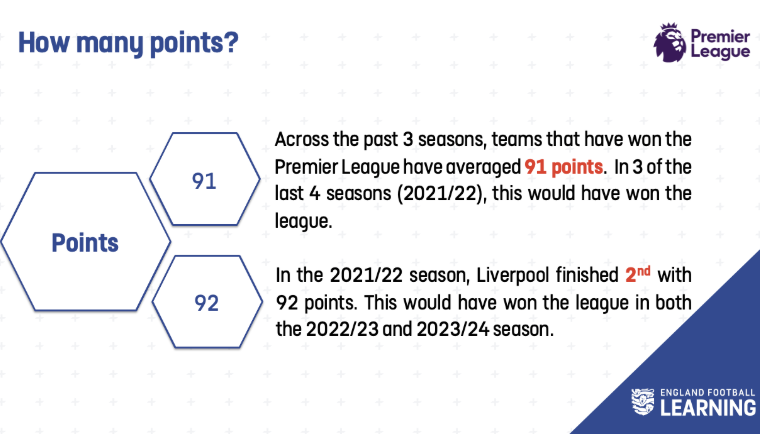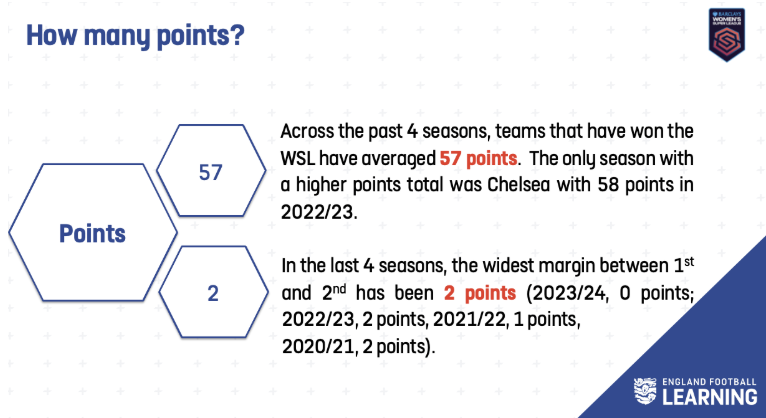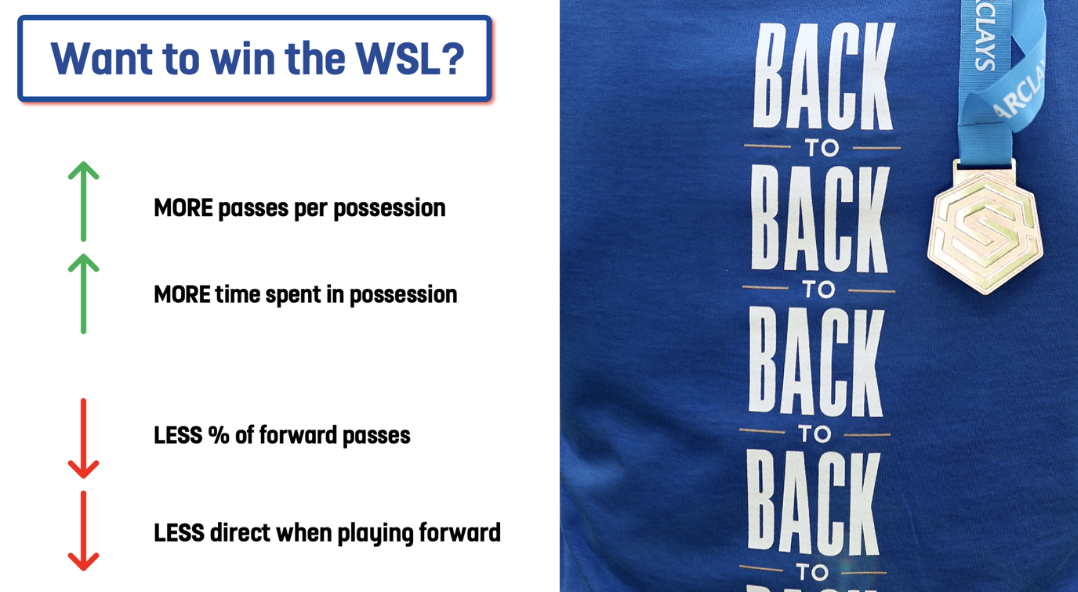Every season, teams set their targets for what they want to achieve - whether that be on a team or individual level. But what is success? How do you judge triumphs? In this blog, Game Insights analyst explores what it takes to win in the Premier League & Women’s Super League.
Whether it be winning the league, qualifying for European football or surviving relegation, all teams will have an idea of what ‘success’ means. There are many ways for teams to meet their targets: game tactics, strategies, systems & styles of play, to name a few. But which method is the most effective? What data metrics indicate a higher chance of success? What trends over the past few seasons suggest a greater chance of winning?
Chelsea have won the WSL 5 seasons in a row & Manchester City have reigned supreme in the EPL for 4 seasons in a row. Tracking data over the last 4 seasons in the WSL and the last 3 seasons in the EPL, some headline data and metrics have stood out to highlight the areas in which these teams have excelled.
Headlines


In the WSL, over a 22-game season, the league winners have averaged 56 points over the last 4 seasons (W18, D2, L2), only 1 point more than 2nd place (W18, D2, L2). In the EPL, over a 38-game season, the league winners have averaged 91 points over the last 3 seasons (W28, D6, L4), 3 points more than 2nd place (W27, D6, L4). Of course – the more points you gain, the more likely you are to be successful!
When looking at goals, the WSL winners averaged 66 scored & 15 conceded – 2nd place averaged 61 goals scored & 12 conceded. In the EPL, the winners averaged 96 goals scored & 31 conceded – 2nd place averaged 91 goals scored & 33 conceded. Interestingly, this suggests that in the WSL, goals scored have an impact on league position, but goals conceded do not; scoring more goals and conceding fewer goals seems to have a positive impact on league position in the EPL.
Tactics, strategies & trends
Looking a bit deeper into how teams play to achieve success, we see that the favoured formation for 3 of the current Top 6 of the EPL (Liverpool, Nottingham Forest & Chelsea) & 3 of the Top 4 of the WSL (Chelsea, Arsenal & Manchester United) is 1-4-2-3-1. Each league has a battle for the top spot by teams with a 1-4-2-3-1 & a 1-4-3-3.
In possession benefits of the 1-4-2-3-1 formation. Goals scored by Chelsea & Liverpool in their 2025 FA Cup campaign.
In the Premier League, a tactical trend is that the less high defensive pressures applied per 90, the higher the league position the team will finish in. As this could be linked to possession (if you have more of the ball, you’re less likely to be applying as many high pressures), it is interesting to further the investigation to look at how things are changing – teams in every position in the league are increasing the number of high defensive pressures they apply season by season. 1st-6th places in 2023/24 applied a similar number of high presses to the relegated teams in 2022/23. Even though high pressures are increasing, the number of ball recoveries is decreasing for all positions in the league. On average, the number of ball recoveries per 90 has dropped by five since 2021/22 – teams can expect to recover the ball around 50 times per match, regardless of position, as this metric has no impact on the final league position.
This trend is the opposite to what we find in the WSL – since 2020/21, teams are recovering possession of the ball around 10 times more per game & the more recoveries a team makes, the more likely that they are to finish higher up the league; in 2023/24, Chelsea (1st) recovered possession 64 times per 90 whereas Bristol City (12th) recovered the ball 53 time per 90.
Looking a bit deeper into how teams play to achieve success, we see that the favoured formation for 3 of the current Top 6 of the EPL (Liverpool, Nottingham Forest & Chelsea) & 3 of the Top 4 of the WSL (Chelsea, Arsenal & Manchester United) is 1-4-2-3-1. Each league has a battle for top spot by teams with a 1-4-2-3-1 & a 1-4-3-3.
In possession benefits of the 1-4-2-3-1 formation. Goals scored by Chelsea & Liverpool in their 2025 FA Cup campaign.
In the Premier League, a tactical trend is that the less high defensive pressures applied per 90, the higher the league position the team will finish in. As this could be linked to possession (if you have more of the ball, you’re less likely to be applying as many high pressures), it is interesting to further the investigation to look at how things are changing – teams in every position in the league are increasing the number of high defensive pressures they apply season by season. 1st-6th places in 2023/24 applied a similar number of high presses to the relegated teams in 2022/23. Even though high pressures are increasing, the number of ball recoveries is decreasing for all positions in the league. On average, the number of ball recoveries per 90 has dropped by five since 2021/22 – teams can expect to recover the ball around 50 times per match, regardless of position, as this metric has no impact on final league position.
This trend is the opposite to what we find in the WSL – since 2020/21, teams are recovering possession of the ball around 10 times more per game & the more recoveries a team makes, the more likely that they are to finish higher up the league; in 2023/24, Chelsea (1st) recovered possession 64 times per 90 whereas Bristol City (12th) recovered the ball 53 time per 90.

Certain events, being higher or lower, suggest that a team is more likely to finish in a certain position. The above image shows trends for teams finishing higher up the league in the WSL.
A consistent trend we see as the seasons pass in the WSL is that all teams are looking to play less direct than the previous season, hold on to the ball for longer, and use their possession with a ‘purpose’. We are seeing:
- UP - total number of passes per possession
- UP - time spent in possession of the ball
- UP – length of time per possession of the ball
- DOWN - direct speed (how quickly a team moves the ball towards their opponent’s goal)
- DOWN - % of passes forwards
- DOWN - % of passes played long
Coaching considerations
- How do we support players to be comfortable & calm in possession once the ball has been turned over?
- What is possession with a purpose? Is it different for every team? How do coaches plan for matchdays with a consideration for possession with a purpose?
- When is the right moment to be slow & indirect or quick & direct? How do we develop this decision-making skill in our players?
- How can coaches develop their observation skills to be able to spot the trends which suggest success in their team – both during games and across the season?
Want more?
- Article – How to develop styles of play
- Session – Passing session: position-specific play

